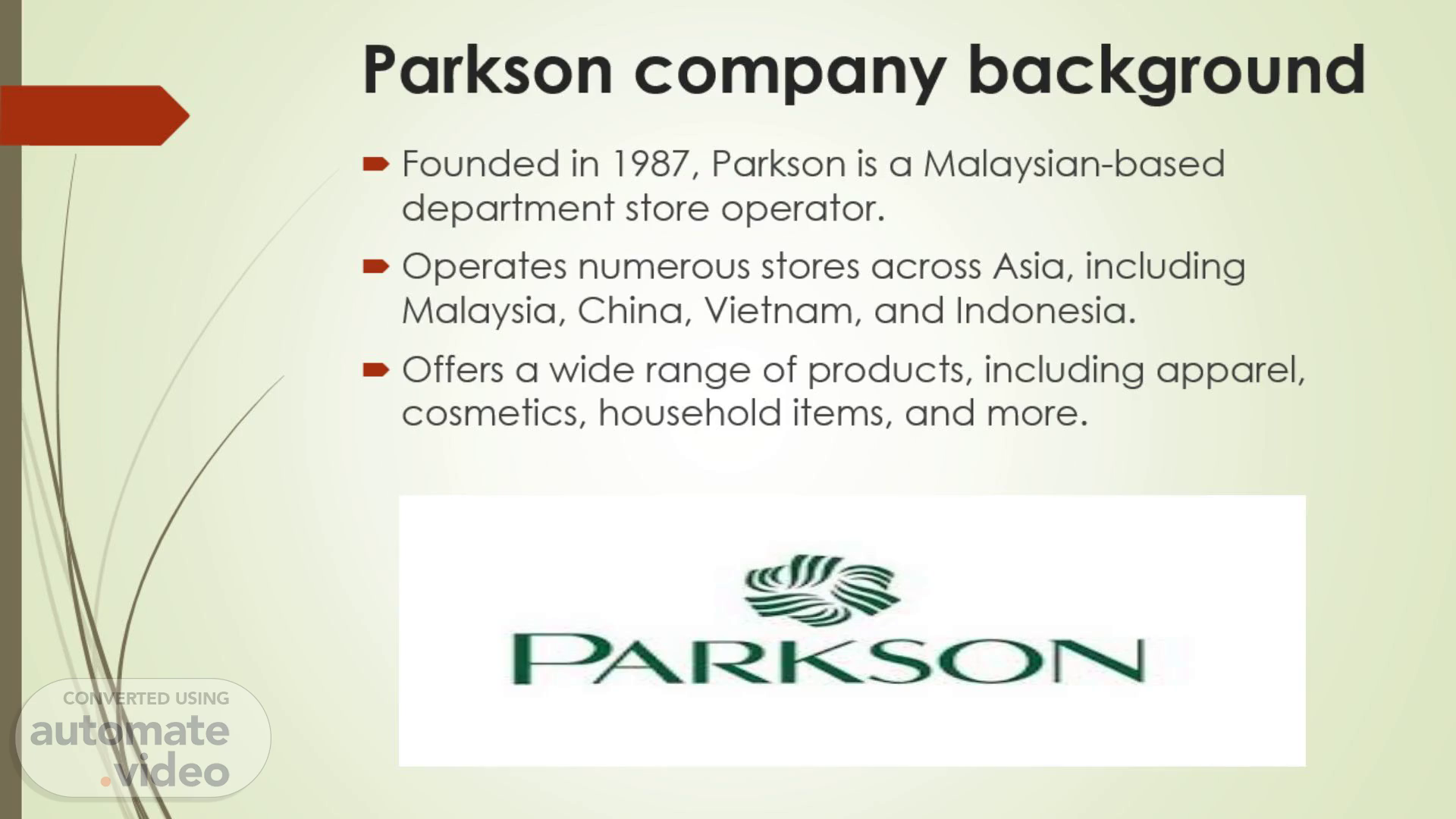
Parkson company background
Scene 1 (0s)
[Audio] Good morning/afternoon everyone. My name is Mohamad Zahar, and I will be guiding you through our presentation today. Let's start by looking at the background of Parkson. Established in 1987, Parkson is a prominent department store operator headquartered in Malaysia. Over the years, Parkson has grown its footprint across Asia, with stores in Malaysia, China, Vietnam, and Indonesia. The company is renowned for offering a broad range of products, including apparel, cosmetics, household items, and more. Parkson caters to a diverse customer base, targeting mid to high-end market segments. Their business model leverages multiple revenue streams, including retail sales, consignment sales, and leasing space to other retailers. This diversified approach has helped Parkson become a key player in the retail industry across the region.".
Scene 2 (56s)
[Audio] Next, let's delve into the background of Padini. My name is Mohamad Zahar, and I'll continue to guide you through this presentation. Founded in 1971, Padini started as a small garment manufacturer and has since evolved into a leading fashion retailer in Malaysia. The company operates various well-known brands, including Padini, Vincci, Seed, and PDI, each catering to different segments of the fashion market. Padini focuses primarily on apparel, footwear, and accessories for men, women, and children, targeting middle-income consumers. With a strong presence in both physical stores and online platforms, Padini has built a reputation for offering trendy, affordable fashion. Their business model centers around specialty stores, allowing them to stay agile and responsive to changing fashion trends and consumer preferences. Padini's growth and success in the competitive fashion retail market is a testament to their effective strategies and strong brand appeal..
Scene 3 (1m 58s)
[Audio] Explanation:- Based on the calculated current ratio, Padini is better than Parkson. This can be seen from the table, Padini has a higher ability to pay its current debt throughout the year from 2019 to 2023. As we can see on 2019 to 2023 Padini current ratio is 3.92 to 4.47 which highest than Parkson current ratio which is on 2019 to 2023 was 1.32 to 0.99 that is smaller compared to Padini. Padini has consistently improved its current ratio over the past five years. This indicates a strong and improving liquidity position, suggesting the Padini has increasingly more current assets relative to its current liabilities. With the current ratio ranging from 3.92 to 4.47, Padini maintains a very comfortable liquidity buffer, meaning it can easily cover its short-term obligations. This reflects prudent financial management and operation efficiently. In comparison, Padini be considered the better-performing company compared to Parkson, as it demonstrates stronger liquidity and more favorable ability to cover short-term obligations. This is because Padini consistently maintains a higher ratio compared to Parkson over the five-year period, Padini's current ratio indicates strong liquidity a healthier balance between current assets and liabilities, providing greater confidence in its ability to meet short-term obligations meanwhile Parkson's current ratio, while fluctuating, generally remains below 1, suggesting potential liquidity challenges and a higher reliance on short-term financing..
Scene 4 (3m 45s)
[Audio] Based on calculated liquidity ratio, Padini is better than Parkson based on quick ratio, the company has higher liquid asset to pay its current debt as compared to Parkson. We can see on the table, Padini quick ratio for 2019 to 2023 was 2.58, 2.58, 3.92, 3.13, 2.72 compared to Parkson which is has lower liquid asset to pay its current debt from 2019 to 2023 was 1.15, 0.73, 0.50, 0.72. 0.84 that is smaller compared to Padini. Padini quick ratio has steadily, indicating a growing capacity to meet short-term liabilities without depending on inventory liquidation. Parkson quick ratio has not only fluctuated but has only consistently declined from 2019 to 2021, particularly falling below the critical threshold of 1.0 from 2020 to 2023 which is Parkson do not have enough liquid assets to cover its short-term liabilities, raising concerns about its immediate liquidity. In comparison, Padini is considered as the better-performing company in term of quick ratio, as it demonstrates stronger liquidity and more favorable ability to cover short-term obligations with its more liquid assets. This is because Padini consistently maintains a higher quick ratio compared to Parkson over five-year period. Padini's quick ratio indicates a stronger ability to cover short-term liabilities with its most liquid assets, reflecting a more robust liquidity position and Parkson's quick ratio generally remains below 1, suggesting potential challenges in meeting short-term obligations with its most liquid assets..